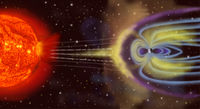
Photo from wikipedia
Geomagnetic disturbances are the results of interplanetary causes such as high-speed streamers (HSSs), interplanetary coronal mass ejections (ICMEs), corotating interaction regions (CIRs), and magnetic clouds. During different forms of geomagnetic… Click to show full abstract
Geomagnetic disturbances are the results of interplanetary causes such as high-speed streamers (HSSs), interplanetary coronal mass ejections (ICMEs), corotating interaction regions (CIRs), and magnetic clouds. During different forms of geomagnetic disturbances, we observed changes in the count rate at neutron monitors that are kept at various locations. We studied the count rates measured by neutron monitors at four stations at various latitudes during different categories of geomagnetic events and compared them. We analysed five events: a geomagnetically quiet event, a non-storm high-intensity long-duration continuous AE activity (HILDCAA) event, a storm-preceded HILDCAA event, a geomagnetic substorm event, and a geomagnetic moderate storm event. We based our analysis on geomagnetic indices, solar wind parameters, and interplanetary magnetic field (IMF) parameters. We found that the strength of the modulation was least during the quiet event and highest during the storm-preceded HILDCAA. By analysing the cause of these geomagnetic disturbances, we related each decrease in the neutron monitor data with the corresponding solar cause. For the ICME-driven storm, we observed a decrease in neutron monitor data ranging from 6% to 12% in all stations. On the other hand, we observed a decrease ranging from 2% to 5% for the HSS-driven storm. For the non-storm HILDCAA, we observed a decrease in neutron monitor data of about 1% to 1.5%. For the quiet event, the neutron monitor data fluctuated such that there was no overall decrease in all stations.
Journal Title: Solar Physics
Year Published: 2017
Link to full text (if available)
Share on Social Media: Sign Up to like & get
recommendations!